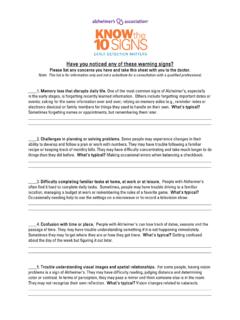Transcription of Hybrid threats as a new ‘wicked problem’ for early warning
1 Hybrid CoEStrategic Analysis May 2018 Hybrid threats as a new wicked problem for early warning PATRICK CULLENS trategic Analysis May 20182 The evolving metaphors of early warning For decades, practitioners and warning intelligence professionals have turned to metaphors to help simplify and commu-nicate to a wider audience the different types of threats facing societies. During the Cold War this conversation often cen-tred on the differences between puzzles and mysteries . After the events of 9/11 radically altered our perceptions of the international threat landscape, the meta-phorical conversation was altered as well.
2 The term wicked problems entered the warning lexicon to describe a new set of dilemmas in warning intelligence. New and unfamiliar non-state actors like Al-Qaida, operating in an increasingly complex and uncertain globalized world, imposed new requirements for early warning . Today, after the annexation of Crimea, we may be witnessing a second inflection point for the metaphor of wicked Hybrid threats cannot be concep-tually reduced to the non-state terrorist threat that gave rise to the post-9/11 con-cept wicked problems , for early warning , the two nevertheless contain many similar-ities. In this vein, Michael D. Reilly (2015) has gone as far as to call Hybrid threats the Pentagon s new wicked problems.
3 He argues that Hybrid threats complicate the precise identification of what is most harm-ful or important, and that the true depth, complexity, and impact of these hazards lies un- or under-recognized until attempts to contend with Hybrid threats are well , today, Hybrid threats represent a new evolution in the wicked-problem set facing the consumers and producers of early warning . Unlike previous wicked problems, Hybrid threats are not wicked due to our unfamiliarity with a new non-state adversary. Nor are Hybrid threats wicked because they operate in a highly complex international environment. In-stead, Hybrid threats are wicked problems by strategic design.
4 This design is often carried out by state actors in an intention-ally ambiguous fashion. This design also creatively exploits a whole range of tools that extend beyond the purely military realm to create negative effects within the targeted society. In doing so, Hybrid threats are designed to blur the distinc-tion between peace and war, as well as complicate and fall below the target s detection and response thresholds. As a result, the wicked problems created by Hybrid threats require new solutions for early warning . Strategic Analysis May 2018 Hybrid threats as a new wicked problem for early warning Hybrid threats are designed to blur the distinction between peace and war, as well as complicate and fall below the target s detection and response thresholds.
5 The wicked problems created by Hybrid threats require new solutions for early warning . writes Patrick Cullen, Senior Research Fellow at the Norwegian Institute of International Affairs (NUPI).Strategic Analysis May 20183 Puzzles, mysteries, and Cold War warning intelligence During the Cold War, puzzles some-times also called secrets referred to information that existed as a brute fact . In other words, puzzles referred to data that was in principle knowable through diligent intelligence-collection efforts. Of course, what is knowable in principle is not always easily knowable in practice. Cold War puzzles were given this name precisely because they often refer to secret information that has intentionally been secured or concealed.
6 Alternatively, mysteries, unlike puzzles, refers to infor-mation that is strictly speaking unknow-able. This is not because of real-world limitations imposed on collection efforts by an adversary defending its secrets, but because mysteries concern contin-gent events (such as a nuclear first strike) that may or may not occur at some point in the future. Since the nature of the type of knowledge attainable for puzzles and mysteries is dif-ferent, collection strategies also differed. Cold War puzzles were investigated with a heavy emphasis on data that could be collected from sensors pointed at adver-sary targets like army barracks or missile installations.
7 Ideally, this data would then be turned into binary yes/no answers to questions on indicator lists ( are these missiles being fuelled?) used by warning officers to determine the actions of the enemy. Mysteries, on the other hand, due to their contingent nature, necessarily involved a heavier emphasis on the role of analysis, risk and probability assess-ments. Despite these differences between puzzles and mysteries, the most likely and threat-ening dangers posed by the Soviet Union were widely understood and agreed upon. Cold War warning intelligence collection and analysis had focused on information related to the Soviet s military sphere, and the vast majority of the indicators and indicator lists generated during this period dealt with various puzzles and mysteries tied to the adversary s armed forces or its military-related activities.
8 By a significant margin, Cold War warn-ing intelligence collection was devoted to obtaining data on key military puzzles: the strengths, capabilities and activities of the armed forces of real and potential state ad-versaries. The collapse of the Soviet Union is a good example of how intelligence col-lection that is devoted to military puzzles does not always prepare for surprises. 9/11 s wicked challenge to indications and warning intelligence The terrorist events of 11 September 2001 came as a shock and a surprise. The attack provided a violent wake-up call for warning intelligence professionals and disrupted the thinking behind early warning indicators.
9 The old and familiar intelligence puzzles and mysteries from the era of the Soviet Union duly became woefully outdated. threats which were well understood, mil-itary-centric, state-based, and relatively static had been replaced by a new threat environment characterized by elusive and evolving transnational threats and threat actors ( terrorist networks) operating in a new milieu of globaliza-tion-driven structural complexity that had exponentially increased the level of uncertainty for the intelligence analyst. As a result, some members of the intel-ligence community began to argue that the indications and warning techniques Strategic Analysis May 20184developed during the Cold War were no longer suitable for countering the novel threats created by non-state actors, and were incapable of anticipating or identi-fying the weak signals generated prior to these attacks.
10 Other, slightly more optimis-tic observers, such as Gregory Treverton (2014), argued that the wicked problems generated by the post-9/11 environment had become so complex that the practical distinction between puzzles and mysteries was beginning to break down. Despite the differences in the epistemological status of the knowledge available to intelligence analysts when studying puzzles and mysteries, the empirical complexity of the new environment required more and more puzzles (and not only mysteries) to be expressed in probabilistic terms. Today, state actors wielding considerably more power than terrorist organizations have demonstrated the ability and willing-ness to design Hybrid threats that match non-kinetic means against the unprotected seams of liberal democratic societies.





